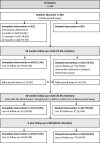Cohort profile: South Australian Aboriginal Birth Cohort (SAABC)-a prospective longitudinal birth cohort
- PMID: 33619192
- PMCID: PMC7903076
- DOI: 10.1136/bmjopen-2020-043559
Cohort profile: South Australian Aboriginal Birth Cohort (SAABC)-a prospective longitudinal birth cohort
Abstract
Purpose: The South Australian Aboriginal Birth Cohort (SAABC) is a prospective, longitudinal birth cohort established to: (1) estimate Aboriginal child dental disease compared with population estimates; (2) determine the efficacy of an early childhood caries intervention in early versus late infancy; (3) examine if efficacy was sustained over time and; (4) document factors influencing social, behavioural, cognitive, anthropometric, dietary and educational attainment over time.
Participants: The original SAABC comprised 449 women pregnant with an Aboriginal child recruited February 2011 to May 2012. At child age 2 years, 324 (74%) participants were retained, at age 3 years, 324 (74%) participants were retained and at age 5 years, 299 (69%) participants were retained. Fieldwork for follow-up at age 7 years is underway, with funding available for follow-up at age 9 years.
Findings to date: At baseline, 53% of mothers were aged 14-24 years and 72% had high school or less educational attainment. At age 3 years, dental disease experience was higher among children exposed to the intervention later rather than earlier in infancy. The effect was sustained at age 5 years, but rates were still higher than general child population estimates. Experiences of racism were high among mothers, with impacts on both tooth brushing and toothache. Compared with population estimates, levels of self-efficacy and self-rated oral health of mothers at baseline were low.
Future plans: Our data have contributed to a better understanding of the environmental, behavioural, dietary, biological and psychosocial factors contributing to Aboriginal child oral and general health, and social and emotional well-being. This is beneficial in charting the trajectory of cohort participants' health and well-being overtime, particularly in identifying antecedents of chronic diseases which are highly prevalent among Aboriginal Australians. Funding for continued follow-up of the cohort will be sought.
Trial registration number: ACTRN12611000111976; Post-results.
Keywords: community child health; epidemiology; public health.
© Author(s) (or their employer(s)) 2021. Re-use permitted under CC BY-NC. No commercial re-use. See rights and permissions. Published by BMJ.
Conflict of interest statement
Competing interests: None declared.
Figures

Similar articles
-
Cohort profile: The Aboriginal Families Study - a prospective cohort of Aboriginal children and their mothers and caregivers in South Australia.BMJ Open. 2024 Aug 22;14(8):e082337. doi: 10.1136/bmjopen-2023-082337. BMJ Open. 2024. PMID: 39179273 Free PMC article.
-
Follow-up of an Intervention to Reduce Dental Caries in Indigenous Australian Children: A Secondary Analysis of a Randomized Clinical Trial.JAMA Netw Open. 2019 Mar 1;2(3):e190648. doi: 10.1001/jamanetworkopen.2019.0648. JAMA Netw Open. 2019. PMID: 30874781 Free PMC article.
-
The effectiveness of a sustained nurse home visiting intervention for Aboriginal infants compared with non-Aboriginal infants and with Aboriginal infants receiving usual child health care: a quasi-experimental trial - the Bulundidi Gudaga study.BMC Health Serv Res. 2018 Aug 3;18(1):599. doi: 10.1186/s12913-018-3394-1. BMC Health Serv Res. 2018. PMID: 30075818 Free PMC article.
-
Early Childhood Caries Intervention in Aboriginal Australian Children: A Cross-in Randomized Trial.JDR Clin Trans Res. 2024 Jul;9(3):239-247. doi: 10.1177/23800844231191714. Epub 2023 Aug 24. JDR Clin Trans Res. 2024. PMID: 37615160 Free PMC article. Clinical Trial.
-
Interventions with pregnant women, new mothers and other primary caregivers for preventing early childhood caries.Cochrane Database Syst Rev. 2019 Nov 20;2019(11):CD012155. doi: 10.1002/14651858.CD012155.pub2. Cochrane Database Syst Rev. 2019. Update in: Cochrane Database Syst Rev. 2024 May 16;5:CD012155. doi: 10.1002/14651858.CD012155.pub3. PMID: 31745970 Free PMC article. Updated.
Cited by
-
"What are we doing to our babies' teeth?" Barriers to establishing oral health practices for Indigenous children in South Australia.BMC Oral Health. 2021 Sep 6;21(1):434. doi: 10.1186/s12903-021-01791-x. BMC Oral Health. 2021. PMID: 34488721 Free PMC article.
-
Oral Health Conditions of Preschool Children Among Birth Cohort Studies: A Scoping Review.Oral Health Prev Dent. 2025 Jun 3;23:315-328. doi: 10.3290/j.ohpd.c_1990. Oral Health Prev Dent. 2025. PMID: 40462701 Free PMC article.
-
Aspirations and Worries: The Role of Parental Intrinsic Motivation in Establishing Oral Health Practices for Indigenous Children.Int J Environ Res Public Health. 2021 Nov 7;18(21):11695. doi: 10.3390/ijerph182111695. Int J Environ Res Public Health. 2021. PMID: 34770211 Free PMC article.
-
Exploratory Graph Analysis of the Strengths and Difficulties Questionnaire for Aboriginal and/or Torres Strait Islander Children.Front Psychol. 2021 Aug 18;12:573825. doi: 10.3389/fpsyg.2021.573825. eCollection 2021. Front Psychol. 2021. PMID: 34484017 Free PMC article.
-
Interventions with pregnant women, new mothers and other primary caregivers for preventing early childhood caries.Cochrane Database Syst Rev. 2024 May 16;5(5):CD012155. doi: 10.1002/14651858.CD012155.pub3. Cochrane Database Syst Rev. 2024. PMID: 38753314 Free PMC article.
References
-
- LG D, Spencer AJ. Oral health of Australian children: the National child oral health study 2012–14. Adelaide: University of Adelaide Press, 2016.
-
- Australian Institute of Health and Welfare Oral health and dental care in Australia: key facts and figures trends 2014. Canberra: AIHW, 2014.
Publication types
MeSH terms
Associated data
LinkOut - more resources
Full Text Sources
Other Literature Sources
